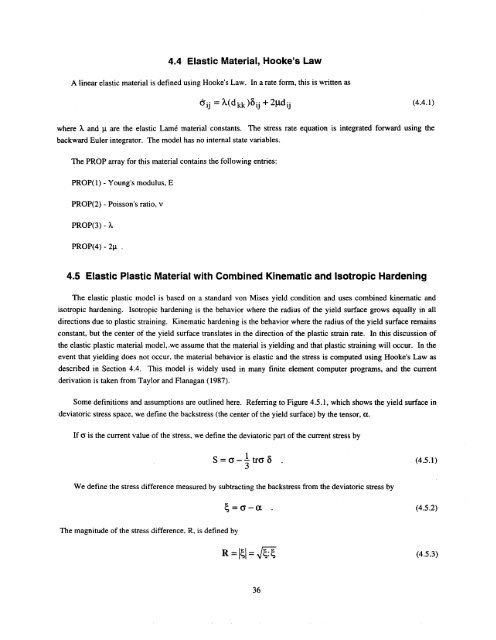II II II II II I - Waste Isolation Pilot Plant - U.S. Department of Energy
II II II II II I - Waste Isolation Pilot Plant - U.S. Department of Energy
II II II II II I - Waste Isolation Pilot Plant - U.S. Department of Energy
- No tags were found...
You also want an ePaper? Increase the reach of your titles
YUMPU automatically turns print PDFs into web optimized ePapers that Google loves.
4.4 Elastic Material, Hooke’s Law<br />
A linear elastic material is defined using Hooke’s Law. In a rate form, this is written as<br />
blj =L(dkk)~ij + z~dij (4.4.1)<br />
where L and w are the elastic Lam6 material constants. The stress rate equation is integrated forward using the<br />
backward Euler integrator. The model has no internal state variables.<br />
The PROP array for this material contains the following entries:<br />
PROP(1) - Young’s modulus, E<br />
PROP(2) - Poisson’s ratio, v<br />
PROP(3) - %<br />
PROP(4) - 2y .<br />
4.5 Elastic Plastic Material with Combined Kinematic and Isotropic Hardening<br />
The elastic plastic model is based on a standard von Mises yield condition and uses combined kinematic and<br />
isotropic hardening. Isotropic hardening is the behavior where the radius <strong>of</strong> the yield surface grows equally in all<br />
directions due to plastic straining. Kinematic hardening is the behavior where the radius <strong>of</strong> the yield surface remains<br />
constant, but the center <strong>of</strong> the yield surface translates in the direction <strong>of</strong> the plastic strain rate. In this discussion <strong>of</strong><br />
the elastic plastic material model, .we assume that the material is yielding and that plastic straining will occur. In the<br />
event that yielding does not occur, the material behavior is elastic and the stress is computed using Hooke’s Law as<br />
described in Section 4.4. This model is widely used in many finite element computer programs, and the current<br />
derivation is taken from Taylor and Flanagan ( 1987).<br />
Some definitions and assumptions are outlined here. Referring to Figure 4.5.1, which shows the yield surface in<br />
deviatoric stress space, we define the backstress (the center <strong>of</strong> the yield surface) by the tensor, et.<br />
If 6 is the current value <strong>of</strong> the stress, we define the deviatoric part <strong>of</strong> the cument stress by<br />
S=+(T5 .<br />
(4.5.1)<br />
We define the stress difference measured by subtracting the backstress from the deviatoric stress by<br />
(4.5.2)<br />
The magnitude <strong>of</strong> the stress difference, R, is defined by<br />
R’lq=lm (4.5.3)<br />
36
















